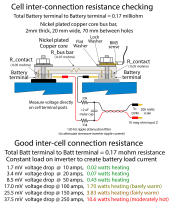I'm new to the practicalities on Lithium and PV, but I do understand power electric generally. I'm struggling to convert my knowledge into practical component selection. Any help is much appreciated. Is this possible and how do I run a 3000W 230VAC inverter off a 200Ah 12V LiFePO battery?
- I'm unlikely to ever run the inverter at 3000W. The highest load might be an induction hob at 2400W and it is likely to run for less than 10 minutes per charge cycle.
- I'd like to limit the battery to a single unit and around 200Ah so that the system can be portable. The SOK 206Ah marine case would be ideal or maybe I need to go DIY to get a big enough BMS in the circuit?
- It will live on a boat that has a 12V lead acid (LA) base system. I'd like the LiFePO system to have a high current 12VDC out. probably on and Anderson plug as occasional back up for the boats LA system. This might mean putting dissimilar chemistries in parallel on occasions and when they re sitting a different voltages. How do I do this safely?
- How do I charge my new LiFePO systems from the boats system. Can I use a VSR to sense the LA is being charged and then charge the LiFePO though a DC - DC converter or is there a better way? The LA common load/charge buss has 460W of PV, a basic engine alternator and a 3500W diesel generator on it.
I've ask these questions of some commercial suppliers? The answer is usually 1000's of $'s if big heavy Victron kit. I'd like budget, small and light for this project.
- I'm unlikely to ever run the inverter at 3000W. The highest load might be an induction hob at 2400W and it is likely to run for less than 10 minutes per charge cycle.
- I'd like to limit the battery to a single unit and around 200Ah so that the system can be portable. The SOK 206Ah marine case would be ideal or maybe I need to go DIY to get a big enough BMS in the circuit?
- It will live on a boat that has a 12V lead acid (LA) base system. I'd like the LiFePO system to have a high current 12VDC out. probably on and Anderson plug as occasional back up for the boats LA system. This might mean putting dissimilar chemistries in parallel on occasions and when they re sitting a different voltages. How do I do this safely?
- How do I charge my new LiFePO systems from the boats system. Can I use a VSR to sense the LA is being charged and then charge the LiFePO though a DC - DC converter or is there a better way? The LA common load/charge buss has 460W of PV, a basic engine alternator and a 3500W diesel generator on it.
I've ask these questions of some commercial suppliers? The answer is usually 1000's of $'s if big heavy Victron kit. I'd like budget, small and light for this project.



